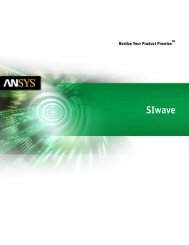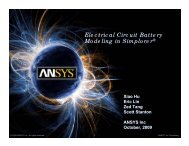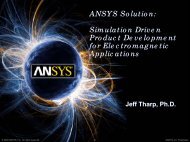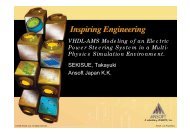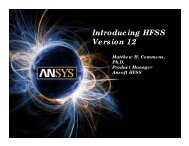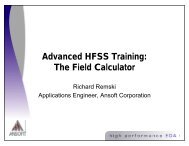ANSYS solutions to Lead Free Package Design Challenges
ANSYS solutions to Lead Free Package Design Challenges
ANSYS solutions to Lead Free Package Design Challenges
You also want an ePaper? Increase the reach of your titles
YUMPU automatically turns print PDFs into web optimized ePapers that Google loves.
<strong>ANSYS</strong> <strong>solutions</strong> <strong>to</strong><br />
<strong>Lead</strong> <strong>Free</strong> <strong>Package</strong><br />
<strong>Design</strong> <strong>Challenges</strong><br />
Kamal Karimanal<br />
Sheldon Imaoka<br />
Vamsi Krishna<br />
© 2009 <strong>ANSYS</strong>, Inc. All rights reserved. 1 <strong>ANSYS</strong>, Inc. Proprietary
Today’s Topic<br />
<strong>ANSYS</strong> Solutions <strong>to</strong><br />
Electronics System <strong>Design</strong><br />
<strong>Challenges</strong><br />
© 2009 <strong>ANSYS</strong>, Inc. All rights reserved. 2 <strong>ANSYS</strong>, Inc. Proprietary
Drivers for <strong>Design</strong> <strong>Challenges</strong><br />
• Shipping and handling exposes electronics <strong>to</strong> shock<br />
and drop events<br />
– Can result in catastrophic failure even from a single<br />
event<br />
• Even normal, recommended end use conditions<br />
subject electronics <strong>to</strong> temperature fluctuations due <strong>to</strong><br />
power on and off<br />
– Thermo mechanical stresses incrementally damage<br />
components with every cycle<br />
– Failure is not about “if”, its about “When”<br />
• Need for life prediction capabilities<br />
© 2009 <strong>ANSYS</strong>, Inc. All rights reserved. 3 <strong>ANSYS</strong>, Inc. Proprietary
<strong>Design</strong> Implication of the <strong>Lead</strong> <strong>Free</strong><br />
Change<br />
PCB Mounting <strong>Design</strong><br />
© 2009 <strong>ANSYS</strong>, Inc. All rights reserved. 4 <strong>ANSYS</strong>, Inc. Proprietary
<strong>Design</strong> Implication of the <strong>Lead</strong> <strong>Free</strong><br />
Change at the <strong>Package</strong> Level<br />
Underfill -<br />
Material & thickness are<br />
coupled with process as<br />
well as product designs<br />
Silicon, IHS, Attach Material selection &<br />
<strong>Design</strong> are completely coupled. Larger<br />
Die = more functionality as well as<br />
reliability issues<br />
Similar <strong>to</strong> balls but entirely<br />
Different size scale issues.<br />
Coupled with underfill delam.<br />
Solder Balls – size, pitch, material<br />
PCB & Substrate pad config, mask<br />
design criteria<br />
© 2009 <strong>ANSYS</strong>, Inc. All rights reserved. 5 <strong>ANSYS</strong>, Inc. Proprietary
<strong>ANSYS</strong> Technologies for <strong>Lead</strong> <strong>Free</strong><br />
<strong>Challenges</strong> at the <strong>Package</strong> Level<br />
Underfill -<br />
Visco elasticity and Cohesive Zone Models<br />
in <strong>ANSYS</strong> Mechanical for product design.<br />
+<br />
VOF modeling capabilities in <strong>ANSYS</strong> CFD <strong>to</strong> model<br />
Capillary driven underfill flow for process design<br />
CZM in <strong>ANSYS</strong> Mechanical<br />
+<br />
Implicit as well as explicit solver<br />
Technologies for shock & drop reliability<br />
Viscoplasticity, creep, physics<br />
coupling needs & scripting<br />
+<br />
Contacts & HPC technology for<br />
Potentially large models in<br />
<strong>ANSYS</strong> Mechanical<br />
Solder Balls – non-linear Visco Plasticity<br />
& Creep models, thermo-mechanical coupling,<br />
If necessary for power cycling analysis. Scripting<br />
Capabilities <strong>to</strong> aid au<strong>to</strong>matic estimation of Fatigue<br />
Life in <strong>ANSYS</strong> Mechanical<br />
© 2009 <strong>ANSYS</strong>, Inc. All rights reserved. 6 <strong>ANSYS</strong>, Inc. Proprietary
<strong>Design</strong> Implication of the <strong>Lead</strong> <strong>Free</strong><br />
Change at the System <strong>Design</strong> Stage<br />
PCB Mounting<br />
<strong>Design</strong><br />
Stiffener plate<br />
© 2009 <strong>ANSYS</strong>, Inc. All rights reserved. 7 <strong>ANSYS</strong>, Inc. Proprietary
<strong>ANSYS</strong> Technologies for the <strong>Lead</strong> <strong>Free</strong><br />
<strong>Challenges</strong> at the System <strong>Design</strong> Stage<br />
PCB Mounting<br />
<strong>Design</strong><br />
Linear Static Structural, Modal and Random<br />
Vibration solver technologies in <strong>ANSYS</strong><br />
Mechanical<br />
Linear/non-linear flexible dynamics using implicit<br />
as well as explicit solver technologies in the<br />
WB environment for shock & drop reliability<br />
Stiffener plate<br />
© 2009 <strong>ANSYS</strong>, Inc. All rights reserved. 8 <strong>ANSYS</strong>, Inc. Proprietary
Today’s Focus:<br />
Solder Joint Reliability<br />
Under Thermal Cycling<br />
Fatigue<br />
© 2009 <strong>ANSYS</strong>, Inc. All rights reserved. 9 <strong>ANSYS</strong>, Inc. Proprietary
Thermo-Mechanics 101<br />
dV<br />
dT<br />
= α V , α − CTE<br />
Un-deformed state<br />
At Elevated Temperature & Moisture Levels<br />
At Temperatures & Moisture levels below un-deformed state<br />
Low CTE<br />
High CTE<br />
© 2009 <strong>ANSYS</strong>, Inc. All rights reserved. 10 <strong>ANSYS</strong>, Inc. Proprietary
Review of Stress Vs. Strain Curve<br />
• Plasticity models describe inelastic behavior<br />
that develops when the stress level goes<br />
beyond the yield strength of the material<br />
– Can be rate-independent or rate-dependent or<br />
coupled with creep<br />
σ<br />
Unloading<br />
Yield Point σ y<br />
Elastic Plastic<br />
© 2009 <strong>ANSYS</strong>, Inc. All rights reserved. 11 <strong>ANSYS</strong>, Inc. Proprietary<br />
ε
Review of Creep<br />
• Materials tend <strong>to</strong> undergo creep at temperature higher then their<br />
Homologous temperature<br />
– Homologous temperature = 0.5 X Melting point (in Kelvin)<br />
• Secondary creep has been known <strong>to</strong> cause Failure of Solder<br />
Joints<br />
ε<br />
Primary<br />
Secondary<br />
Rupture<br />
Tertiary<br />
© 2009 <strong>ANSYS</strong>, Inc. All rights reserved. 12 <strong>ANSYS</strong>, Inc. Proprietary<br />
t<br />
&<br />
ε =<br />
f<br />
( σ ) f ( ε ) f ( t)<br />
f ( T )<br />
cr 1 2 3 4
Thermal Expansion Implications <strong>to</strong><br />
Electronics<br />
• No Permanent damage for perfectly elastic<br />
materials<br />
• Among the IC package parts that undergo plastic<br />
deformation and/or creep, solder joints are the<br />
most susceptible <strong>to</strong> failure<br />
• For Most Consumer electronics, thermal cycling<br />
is the main cause for fatigue failure<br />
© 2009 <strong>ANSYS</strong>, Inc. All rights reserved. 13 <strong>ANSYS</strong>, Inc. Proprietary
Time To Failure (TTF) Prediction<br />
• For solder joint reliability, prediction of life in<br />
<strong>ANSYS</strong> is based on two Choices:<br />
– Choice of fatigue model<br />
– Choice of constitutive model<br />
• This is a material model that <strong>to</strong> be used in FEA that<br />
captures<br />
&<br />
ε =<br />
f<br />
( σ ) f ( ε ) f ( t)<br />
f ( T )<br />
cr 1 2 3 4<br />
© 2009 <strong>ANSYS</strong>, Inc. All rights reserved. 14 <strong>ANSYS</strong>, Inc. Proprietary
Fatigue model chosen for this work<br />
• Following taken from R. Darveaux, “Effect of Simulation Methodology<br />
on Solder Joint Crack Growth Correlation”, ECTC 2000<br />
• Crack Initiation:<br />
• Crack growth:<br />
• Characteristic life:<br />
N = K ΔW<br />
0<br />
da<br />
dN<br />
α<br />
W<br />
=<br />
K<br />
1<br />
3<br />
ΔW<br />
• The characteristic life α W is then related <strong>to</strong> the failure free life and<br />
cycles <strong>to</strong> first failure for failure prediction<br />
K2<br />
avg<br />
K4<br />
avg<br />
a<br />
= N0<br />
+<br />
da<br />
dN<br />
Here, K 1 through K 4 are<br />
parameters estimated by<br />
correlating ΔW avg from<br />
simulation predictions <strong>to</strong> test<br />
data of N 0 and crack growth<br />
rate<br />
a is the joint diameter at the<br />
interface (‘final crack length’)<br />
ΔW is the plastic work per<br />
cycle<br />
© 2009 <strong>ANSYS</strong>, Inc. All rights reserved. 15 <strong>ANSYS</strong>, Inc. Proprietary
Choice of Constitutive Model<br />
• Choice of constitutive model is tied <strong>to</strong> the<br />
model used <strong>to</strong> determine K 1 through K 4<br />
• In this work we will use K 1 through K 4<br />
determined by Darveaux using Anand<br />
Constitutive Model<br />
• Hence Anand Constitutive model is used in<br />
this work<br />
© 2009 <strong>ANSYS</strong>, Inc. All rights reserved. 16 <strong>ANSYS</strong>, Inc. Proprietary
Characterization Methodology<br />
(Darveaux, 2000)<br />
Cycles <strong>to</strong> initiation<br />
Pro<strong>to</strong>type<br />
Geometry<br />
+<br />
Material Models<br />
Determine K 1 and K 2<br />
Strain Energy Density (from simulation)<br />
Thermal Cycling<br />
Test<br />
<strong>ANSYS</strong> Simulation<br />
of Thermal Cycling<br />
Test<br />
© 2009 <strong>ANSYS</strong>, Inc. All rights reserved. 17 <strong>ANSYS</strong>, Inc. Proprietary<br />
Rate of Crack Growth<br />
N o, , Cycles <strong>to</strong> initiation<br />
Rate of Crack Growth<br />
Strain Energy Density<br />
Or<br />
Plastic work<br />
Determine K 3 and K 4<br />
Strain Energy Density (from simulation)
Solder Joint Fatigue<br />
Simulation in <strong>ANSYS</strong><br />
Workbench Environment<br />
© 2009 <strong>ANSYS</strong>, Inc. All rights reserved. 18 <strong>ANSYS</strong>, Inc. Proprietary
<strong>ANSYS</strong> Workbench Workflow for<br />
Fatigue Simulation<br />
Detailed BGA<br />
from Macro<br />
<strong>ANSYS</strong> Workbench<br />
<strong>ANSYS</strong><br />
<strong>Design</strong>Modeler<br />
<strong>ANSYS</strong> Unified<br />
Meshing Platform<br />
Material props, Solver Settings<br />
Ansys Mechanical<br />
for<br />
Thermal Cycling Stress<br />
Simulation<br />
Post processing APDL<br />
for Cycles <strong>to</strong> failure<br />
© 2009 <strong>ANSYS</strong>, Inc. All rights reserved. 19 <strong>ANSYS</strong>, Inc. Proprietary
BGA Geometry Creation Macro<br />
• Ball Grid Arrays (BGA)<br />
type <strong>Package</strong>s are well<br />
suited for cus<strong>to</strong>mization<br />
because of their<br />
standardized geometry<br />
© 2009 <strong>ANSYS</strong>, Inc. All rights reserved. 20 <strong>ANSYS</strong>, Inc. Proprietary
Geometric Details and Simulation<br />
Intent<br />
© 2009 <strong>ANSYS</strong>, Inc. All rights reserved. 21 <strong>ANSYS</strong>, Inc. Proprietary
Geometric Details and Simulation<br />
Intent<br />
Substrate<br />
PAD<br />
SMD Mask<br />
NSMD Pad<br />
PCB mask Opening<br />
(NSMD)<br />
© 2009 <strong>ANSYS</strong>, Inc. All rights reserved. 22 <strong>ANSYS</strong>, Inc. Proprietary
Geometric Details and Simulation<br />
Intent<br />
© 2009 <strong>ANSYS</strong>, Inc. All rights reserved. 23 <strong>ANSYS</strong>, Inc. Proprietary
Geometry - Possible Simplifications<br />
© 2009 <strong>ANSYS</strong>, Inc. All rights reserved. 24 <strong>ANSYS</strong>, Inc. Proprietary
Simulation Intent, WB Mesh Control and<br />
Contacts Technology<br />
© 2009 <strong>ANSYS</strong>, Inc. All rights reserved. 25 <strong>ANSYS</strong>, Inc. Proprietary
Material Models and Material<br />
Properties Used for Sample Case<br />
All materials are linear elastic except the solder ball, which uses Anand rate<br />
Dependent plasticity model<br />
Silicon<br />
Underfill<br />
Solder, Anand model<br />
Mask<br />
PCB and BT resin<br />
orthotropic Young’s<br />
Modulus and CTE<br />
© 2009 <strong>ANSYS</strong>, Inc. All rights reserved. 26 <strong>ANSYS</strong>, Inc. Proprietary
Property Values and Anand Model<br />
Constants<br />
• PCB, BT, mask, Silicon, and Solder property<br />
values were used from:<br />
– “Impact of ball via configurations on solder<br />
joint reliability in tape-based, chip-scale<br />
packages” Zahn Bret A. , 52nd electronic<br />
components & technology conference : ( San<br />
Diego CA, 28-31 May 2002 )<br />
© 2009 <strong>ANSYS</strong>, Inc. All rights reserved. 27 <strong>ANSYS</strong>, Inc. Proprietary
Commands Object for Orthotropic CTE<br />
and Plasticity Models<br />
Parameters for Commands objects can be input from Details window in the GUI<br />
© 2009 <strong>ANSYS</strong>, Inc. All rights reserved. 28 <strong>ANSYS</strong>, Inc. Proprietary
Commands Object for Anand Model<br />
• Variable names ARG1,<br />
ARG2 etc in the APDL<br />
instruct WB <strong>to</strong> take<br />
inputs from the Details<br />
window for the<br />
corresponding<br />
commands object.<br />
© 2009 <strong>ANSYS</strong>, Inc. All rights reserved. 29 <strong>ANSYS</strong>, Inc. Proprietary
Thermal Cycle Input<br />
© 2009 <strong>ANSYS</strong>, Inc. All rights reserved. 30 <strong>ANSYS</strong>, Inc. Proprietary
User Choice for Performing Fatigue<br />
Calculations<br />
Named selections for sections of the solder joint<br />
expected <strong>to</strong> experience highest plastic strain<br />
fluctuations<br />
© 2009 <strong>ANSYS</strong>, Inc. All rights reserved. 31 <strong>ANSYS</strong>, Inc. Proprietary
Fatigue Post-Processing Calculations<br />
APDL inserted as command<br />
Object in Solution branch<br />
Results are calculated after<br />
Solution is completed<br />
“My_...” variables in the script<br />
make results appear in the<br />
Details window<br />
• Sample macros will be available for download at<br />
<strong>ANSYS</strong> Cus<strong>to</strong>mer portal<br />
© 2009 <strong>ANSYS</strong>, Inc. All rights reserved. 32 <strong>ANSYS</strong>, Inc. Proprietary
Results and<br />
Discussion<br />
© 2009 <strong>ANSYS</strong>, Inc. All rights reserved. 33 <strong>ANSYS</strong>, Inc. Proprietary
Cycles <strong>to</strong> failure calculation<br />
© 2009 <strong>ANSYS</strong>, Inc. All rights reserved. 34 <strong>ANSYS</strong>, Inc. Proprietary
Plastic strain on all solders<br />
© 2009 <strong>ANSYS</strong>, Inc. All rights reserved. 35 <strong>ANSYS</strong>, Inc. Proprietary
Stresses on solder pad<br />
© 2009 <strong>ANSYS</strong>, Inc. All rights reserved. 36 <strong>ANSYS</strong>, Inc. Proprietary
<strong>ANSYS</strong> Software Products Needed<br />
• <strong>ANSYS</strong> <strong>Design</strong>Modeler<br />
• <strong>ANSYS</strong> Mechanical<br />
© 2009 <strong>ANSYS</strong>, Inc. All rights reserved. 37 <strong>ANSYS</strong>, Inc. Proprietary
How Can <strong>ANSYS</strong> Help You?<br />
• BGA geometry creation macro<br />
• Workflow instructions<br />
– <strong>ANSYS</strong> Workbench<br />
Capabilities for geometry<br />
processing and meshing<br />
– Material models in <strong>ANSYS</strong><br />
Mechanical<br />
– Sample APDL scripts for GUI<br />
based user inputs for Material<br />
models and Fatigue Model<br />
• Sample <strong>ANSYS</strong> Workbench<br />
Project<br />
• Jump start assistance through<br />
service projects<br />
• Focused Training?<br />
© 2009 <strong>ANSYS</strong>, Inc. All rights reserved. 38 <strong>ANSYS</strong>, Inc. Proprietary
Take Home Material<br />
• The following materials have already been<br />
uploaded <strong>to</strong> <strong>ANSYS</strong> Cus<strong>to</strong>mer Portal<br />
– A workflow Tu<strong>to</strong>rial for performing Fatigue<br />
Calculation using Anand constitutive model<br />
and Plasticity based TTF prediction<br />
– A sample model containing more details and<br />
finer mesh than the tu<strong>to</strong>rial problem will also<br />
be available from <strong>ANSYS</strong> Cus<strong>to</strong>mer Portal.<br />
© 2009 <strong>ANSYS</strong>, Inc. All rights reserved. 39 <strong>ANSYS</strong>, Inc. Proprietary
Conclusions<br />
• We presented an overview of design challenges in<br />
electronics due <strong>to</strong> lead free transition<br />
– Focused on package specific challenges<br />
• Highlighted why <strong>ANSYS</strong> technology is best suited <strong>to</strong><br />
address these challenges<br />
• Used Solder Joint Fatigue simulation of a BGA<br />
package <strong>to</strong> illustrate workbench based workflow<br />
using <strong>ANSYS</strong> Mechanical software<br />
© 2009 <strong>ANSYS</strong>, Inc. All rights reserved. 40 <strong>ANSYS</strong>, Inc. Proprietary
Conclusions<br />
• Example workflow illustrated the following unique strengths<br />
– Geometry creation time savings due <strong>to</strong> <strong>Design</strong>Modeler Macro for BGA<br />
– <strong>ANSYS</strong> Meshing platform for high quality refined mesh where needed<br />
– Contacts technology for computational cost savings<br />
– Productivity enhancements through Au<strong>to</strong>matic Contact detection<br />
– Time tested <strong>ANSYS</strong> Mechanical solver with advanced non-linear models<br />
• Viscoplasticty and creep modeling capabilities<br />
– Workbench platform bridges the power of solver lever manipulation using<br />
APDL with user friendliness<br />
© 2009 <strong>ANSYS</strong>, Inc. All rights reserved. 41 <strong>ANSYS</strong>, Inc. Proprietary
Thank You!<br />
© 2009 <strong>ANSYS</strong>, Inc. All rights reserved. 42 <strong>ANSYS</strong>, Inc. Proprietary







